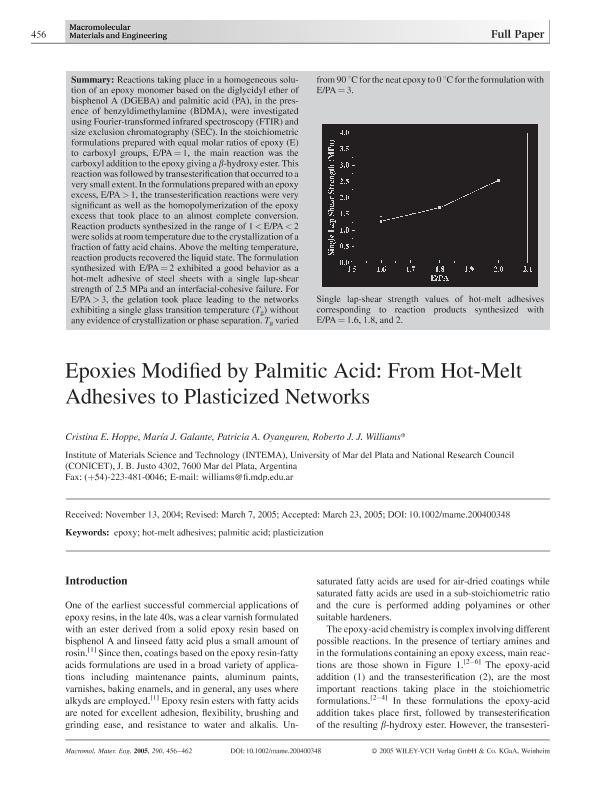Artículo
Epoxies modified by palmitic acid: From hot-melt adhesives to plasticized networks
Hoppe, Cristina Elena ; Galante, Maria Jose
; Galante, Maria Jose ; Oyanguren, Patricia Angelica
; Oyanguren, Patricia Angelica ; Williams, Roberto Juan Jose
; Williams, Roberto Juan Jose
 ; Galante, Maria Jose
; Galante, Maria Jose ; Oyanguren, Patricia Angelica
; Oyanguren, Patricia Angelica ; Williams, Roberto Juan Jose
; Williams, Roberto Juan Jose
Fecha de publicación:
05/2005
Editorial:
Wiley VCH Verlag
Revista:
Macromolecular Materials and Engineering (print)
ISSN:
1438-7492
Idioma:
Inglés
Tipo de recurso:
Artículo publicado
Clasificación temática:
Resumen
Reactions taking place in a homogeneous solution of an epoxy monomer based on the diglycidyl ether of bisphenol A (DGEBA) and palmitic acid (PA), in the presence of benzyldimethylamine (BDMA), were investigated using Fourier‐transformed infrared spectroscopy (FTIR) and size exclusion chromatography (SEC). In the stoichiometric formulations prepared with equal molar ratios of epoxy (E) to carboxyl groups, E/PA = 1, the main reaction was the carboxyl addition to the epoxy giving a β‐hydroxy ester. This reaction was followed by transesterification that occurred to a very small extent. In the formulations prepared with an epoxy excess, E/PA > 1, the transesterification reactions were very significant as well as the homopolymerization of the epoxy excess that took place to an almost complete conversion. Reaction products synthesized in the range of 1 < E/PA < 2 were solids at room temperature due to the crystallization of a fraction of fatty acid chains. Above the melting temperature, reaction products recovered the liquid state. The formulation synthesized with E/PA = 2 exhibited a good behavior as a hot‐melt adhesive of steel sheets with a single lap‐shear strength of 2.5 MPa and an interfacial‐cohesive failure. For E/PA > 3, the gelation took place leading to the networks exhibiting a single glass transition temperature (Tg) without any evidence of crystallization or phase separation. Tg varied from 90 °C for the neat epoxy to 0 °C for the formulation with E/PA = 3.
Palabras clave:
EPOXY
,
HOT-MELT ADHESIVES
,
PALMITIC ACID
,
PLASTICIZATION
Archivos asociados
Licencia
Identificadores
Colecciones
Articulos(INTEMA)
Articulos de INST.DE INV.EN CIENCIA Y TECNOL.MATERIALES (I)
Articulos de INST.DE INV.EN CIENCIA Y TECNOL.MATERIALES (I)
Citación
Hoppe, Cristina Elena; Galante, Maria Jose; Oyanguren, Patricia Angelica; Williams, Roberto Juan Jose; Epoxies modified by palmitic acid: From hot-melt adhesives to plasticized networks; Wiley VCH Verlag; Macromolecular Materials and Engineering (print); 290; 5; 5-2005; 456-462
Compartir
Altmétricas



